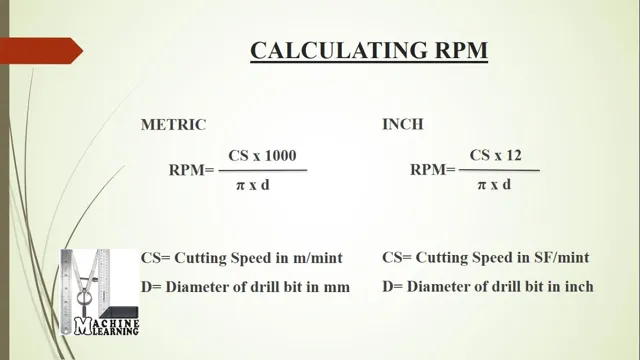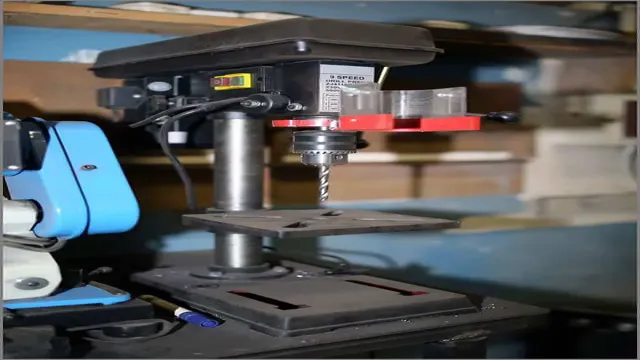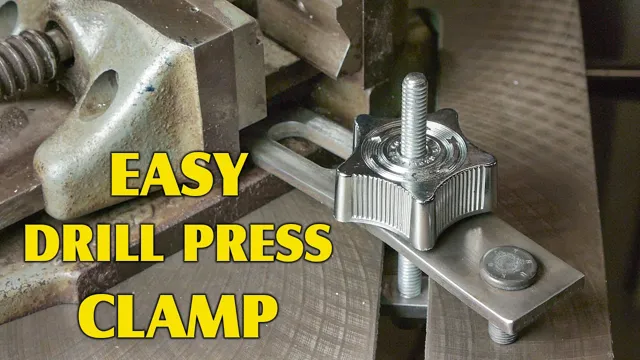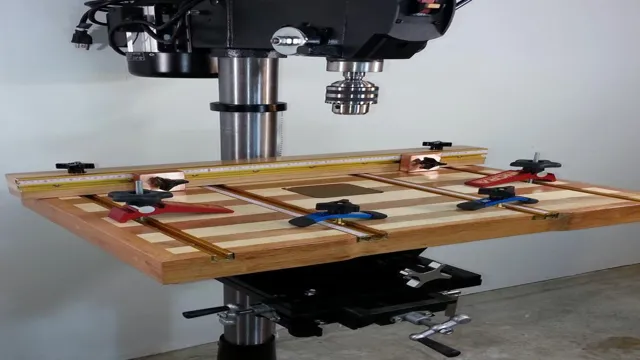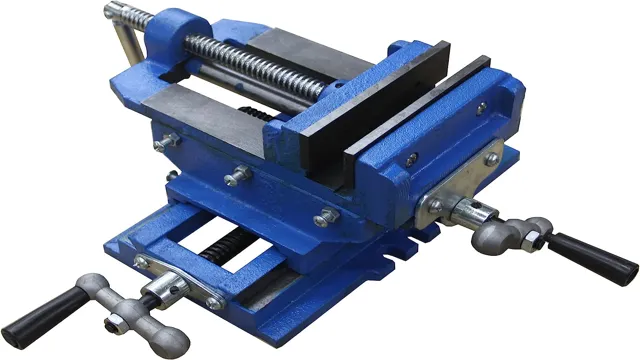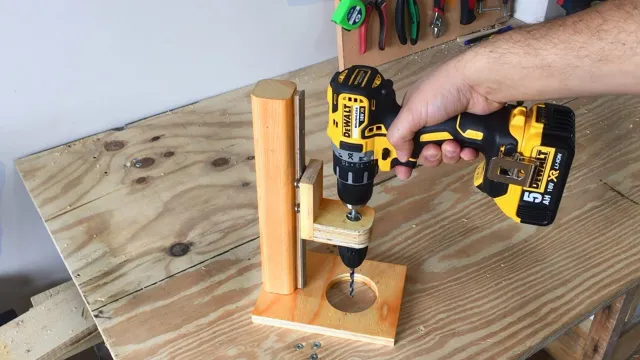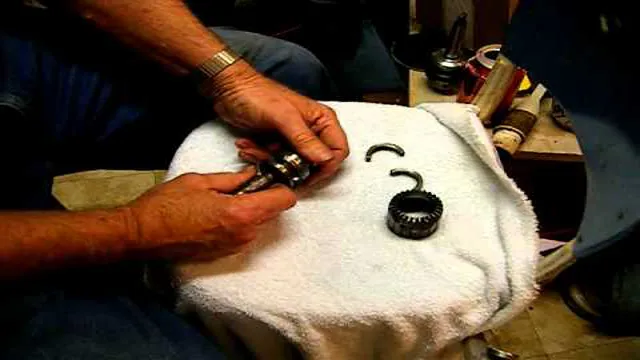How Does a Bench Drill Press Work: A Comprehensive Guide to Understanding Its Mechanism
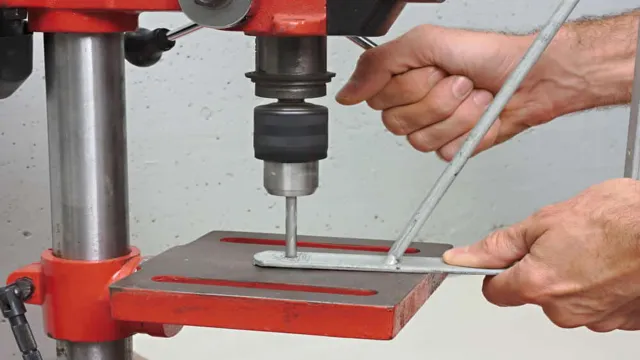
Have you ever marveled at the precision and accuracy of a bench drill press? It’s an impressive machine that can drill through tough materials like wood, metal, and plastic with ease. But have you ever stopped to wonder how it actually works? In this blog post, we’ll take you through the basics of how a bench drill press operates and what makes it such a valuable tool in the workshop. From the motor to the chuck, we’ll break down each component and how it plays a vital role in the drilling process.
So, let’s dive in and explore the inner workings of this essential workshop staple!
Overview of a Bench Drill Press
If you are new to the world of drilling, you might be wondering how a bench drill press works. Essentially, a drill press is a versatile machine designed to create holes in a variety of materials including metal, wood, and plastic. The way it works is simple – you mount the material you want to drill onto the drill press table, adjust the speed and depth of the drill bit, and then turn on the machine.
The drill bit spins at high speed, creating a hole in the material. Bench drill presses are ideal for DIY projects, woodworking, metalworking, and more. They are relatively easy to use and can be adjusted to accommodate different sized drill bits for diverse applications.
The precision of bench drill presses also makes them an essential tool for professional workshops and factories where accuracy is paramount. Overall, bench drill presses are a great investment for anyone looking for a reliable, powerful and versatile tool.
Components of a Bench Drill Press
A bench drill press is a versatile tool that can help you make holes in a range of materials, including metal, wood, and plastic. Understanding the different components of a bench drill press is crucial to make the most of this tool. Firstly, the base of a bench drill press is vital because it provides stability while in use.
The column is mounted on the base, and it supports the drill press head, which consists of the motor, quill feed handle, and spindle. The table is adjustable, which means that it can be moved up or down and can also be tilted to allow you to make angled holes. The chuck and drill bit are the actual cutting components that do the work.
The chuck connects the drill bit with the spindle, and it can be adjusted to hold bits of different sizes. By understanding the different parts of a bench drill press, you’ll be able to make precise holes that meet your specific needs and requirements.
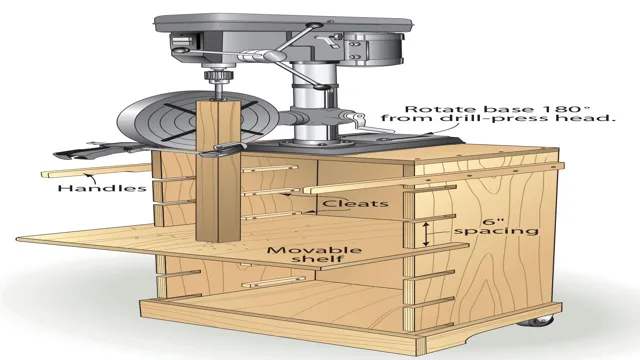
Mechanism of a Bench Drill Press
A bench drill press is a versatile tool used by both DIY enthusiasts and professional workers. It allows for precise drilling of holes into various materials including wood, metal and plastics. The mechanism of a bench drill press includes an electric motor that powers a spindle to turn and a chuck to hold the drill bit.
The operator rotates the chuck and locks it in place to secure the drill bit. The material is then positioned under the drill bit and the quill feed handle is used to press down on the material, causing the drill bit to make contact and commence the drilling process. The depth of the drill bit can be adjusted using the depth stop gauge, allowing for consistent drilling and clean finishes.
The bench drill press is an essential addition to any workshop, providing efficient and accurate drilling capabilities.
Using a Bench Drill Press
If you’re looking to conduct precise and accurate drilling, then a bench drill press is a valuable tool for your workshop. A bench drill press works by drilling through various materials such as metal, wood, and plastic. It operates by rotating a drill bit at high speeds and with precise torque while being guided through the drilling process.
The machine consists of a base, column, head, table, and other parts that work together to ensure stable and reliable drilling. It is equipped with various speed adjustments, and the drill bit can be changed according to the required size and material. To use the bench drill press, you need to set up the material to be drilled on the table and adjust the depth and alignment of the drilling.
Then, simply switch on the machine, adjust the speed according to the material, and apply steady downward pressure on the handle to guide the drill bit through the material. Overall, a bench drill press is a versatile and essential tool for any craftsman looking to achieve precision and accuracy in drilling.
Preparing the Drill Press
Preparing a bench drill press is a simple yet meticulous task. Before starting any project, it’s crucial to check if the drill press is clean and debris-free to avoid damage to the equipment and ensure accurate drilling. Start by removing any leftover materials from the previous project.
Next, adjust the table height and lock it in place to prevent accidental movement while drilling. The next step is to attach the appropriate drill bit to the chuck and adjust the speed and depth of drilling according to the material being used. Safety goggles are a must for any drilling activity, and it’s best to keep them on throughout the process.
With these precautions in place, you’re ready to start your project. Remember to double-check all settings, and keep your hands and fingers away from the drill bit when it’s in motion to avoid accidents. So, get your bench drill press prepared to start your next project effortlessly and safely.
Setting up the Workpiece
When setting up a workpiece for drilling, a bench drill press can be a useful tool. Start by securing the workpiece to the table of the drill press using clamps or a vise. This will prevent any movement or slipping during the drilling process.
Next, adjust the depth stop on the drill press to ensure that the drill bit does not go too deep into the workpiece. This is especially important if you need to drill multiple holes at the same depth. Once everything is secure and in place, turn on the drill press and begin drilling.
Remember to always wear protective eyewear and keep your hands away from the rotating drill bit. With a little practice and attention to detail, you will be able to set up your workpiece like a pro and tackle any drilling project with ease.
Operating the Drill Press
Operating a bench drill press can seem intimidating at first, but with proper guidance, it can be a straightforward process. The first step is to ensure that all the necessary materials are available to you, such as the safety goggles and clamps that will be used to secure the material you are working with. Once you have your materials, you can turn on the drill press and set the speed to match the material you are working with.
Next, you’ll need to adjust the table height and position the drill bit in the center of the material. With these preparations complete, you can begin drilling by lowering the drill bit onto the material and applying gentle pressure. Remember to keep your hand steady, and don’t force the bit through the material.
Lastly, make sure to turn off the drill press when you are finished and clean up the area. Following these basic steps can help ensure a safe and efficient drilling experience with your bench drill press.
Safety Precautions with a Bench Drill Press
If you’re wondering how a bench drill press works, it’s a piece of equipment used to drill holes into various materials, such as wood, metal, and plastic. The drill press has a motor that powers the spindle and chuck, which hold the drill bit. When the operator lowers the bit onto the material, the drill bit spins rapidly, creating a hole.
However, it’s important to take safety precautions when using a bench drill press. Always wear protective gear, such as safety glasses or face shields to prevent any debris from flying into your eyes. It’s also crucial to clamp the material securely to prevent it from moving or spinning during drilling.
Additionally, never wear loose clothing or jewelry that could get caught in the machine, and always disconnect the power source before making any adjustments or changing the drill bit. By following these safety tips, you can safely and efficiently operate a bench drill press while achieving accurate and precise drilling results.
Protective Gear
When operating a bench drill press, safety should always be top of mind. One of the most crucial safety precautions you can take is wearing proper protective gear. This includes safety glasses or goggles to protect your eyes from flying debris and gloves to prevent cuts and scrapes.
It’s also important to wear appropriate clothing that is snug-fitting and devoid of loose items that could get caught in the drill bit. Additionally, if you have long hair, be sure to tie it back or wear a hairnet to prevent entanglement with the moving parts. By taking these simple yet effective safety precautions, you can minimize the risk of injury and make your bench drill press experience safer and more enjoyable.
Machine Safety Measures
Safety Precautions with a Bench Drill Press When working with a bench drill press, it’s essential to take certain safety measures. Firstly, always wear appropriate protective gear, such as safety glasses or a face shield, to prevent any debris or metal shavings from getting into your eyes. Secondly, keep your fingers and loose clothing away from the rotating drill bit at all times.
Additionally, make sure to secure your workpiece to the table firmly and securely to prevent it from shifting or spinning while drilling. Always use the correct drill bit size that matches the type of material you’re working with, as using an incorrect drill bit can cause harm and damage to the machine. Finally, before turning on the drill press, ensure that the power switch is off and the drill bit is correctly positioned.
By following these safety precautions, you can reduce the risk of injury or damage when working with a bench drill press.
Maintenance of a Bench Drill Press
Bench drill presses are versatile and powerful tools that allow you to drill and bore holes with precision and speed. But, like any mechanical device, a bench drill press requires maintenance to keep it running smoothly and prevent damage or failure. The key to maintaining a bench drill press is to keep it clean and lubricated.
Dust and debris can build up on the machine and cause it to bind or slip, so be sure to wipe it down after each use. You can also use a can of compressed air to blow out any accumulated debris. Additionally, make sure to check the belts, gears, and chuck regularly to ensure they are well-lubricated and properly adjusted.
It’s also important to keep the drill bits sharp and replace them when they become worn or damaged. By taking these steps, you can help prolong the life of your bench drill press and keep it working efficiently. So, now you know how a bench drill press works and how to maintain it to ensure optimal performance.
Conclusion
In summary, the bench drill press is like having a personal drilling assistant that never gets tired or lazy. Its precision and power are unmatched, allowing you to create clean and accurate holes effortlessly. With its reliable motor and adjustable features, the bench drill press is a must-have tool for any serious DIYer or professional woodworker.
So, get your hands on one of these bad boys and let the drilling commence!”
FAQs
What is a bench drill press, and how does it work?
A bench drill press is a stationary tool that is designed to drill holes accurately and precisely into a variety of materials such as wood, metal, and plastic. It works by using an electric motor to rotate the drill bit, which is then lowered onto the material.
What are the benefits of using a bench drill press?
The benefits of using a bench drill press include precise drilling, consistent drilling depth, more efficient work, and the ability to perform a variety of drill bit operations quickly and easily.
How do I choose the right bench drill press for my needs?
When choosing a bench drill press, consider the size of the drill press, the power of the motor, the depth of drilling, the type of chuck, the number of spindle speeds, and the type of material you will be working with.
Can bench drill presses be used for other operations besides drilling?
Yes, bench drill presses can also be used for tapping threads, reaming, countersinking, and even sanding and polishing with special attachments.
How do I maintain my bench drill press?
To maintain your bench drill press, keep it clean and free of debris, periodically check for alignment and adjustment, lubricate any moving parts, and replace any worn or damaged parts as necessary.
What safety precautions should I follow when using a bench drill press?
Always wear appropriate eye and ear protection, avoid loose clothing and jewelry, keep long hair tied back, and use clamps or a vise to secure your material to the table. Never touch the drill bit or other moving parts while the drill press is in use.
Can bench drill presses be used for industrial applications?
Yes, bench drill presses can be used for light to medium-duty industrial applications, but heavier duty work typically requires a floor-standing drill press. It’s important to choose a drill press that is capable of handling the type of work you will be doing.

